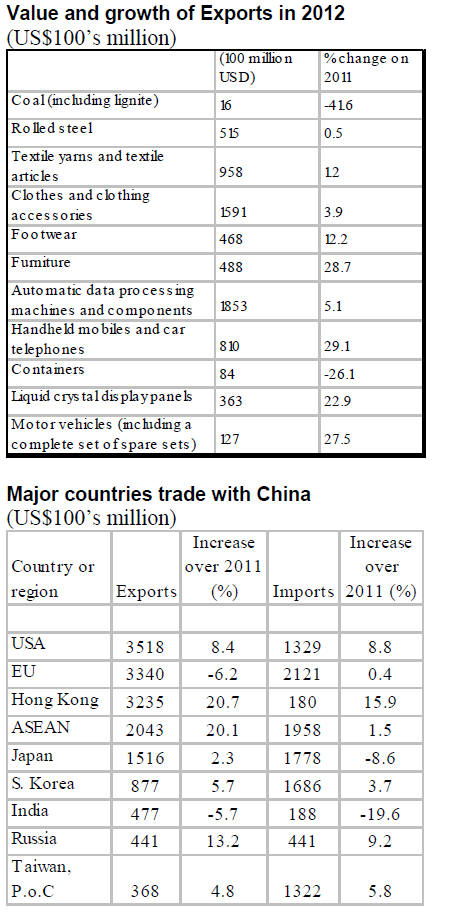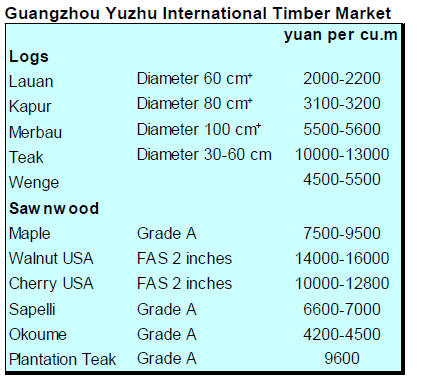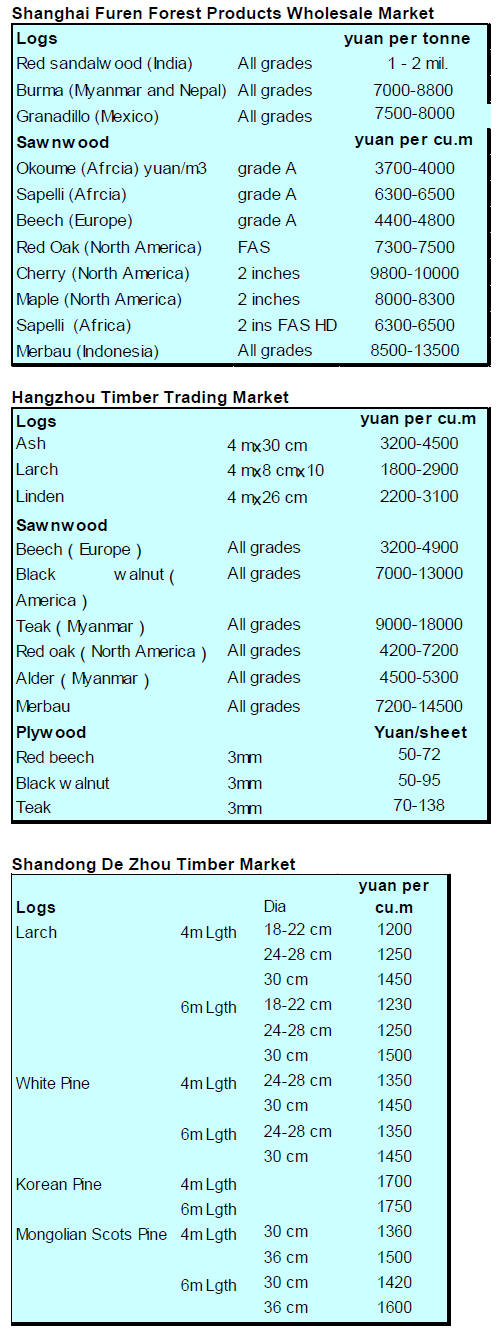US Dollar Exchange Rates of 21th February 2013
China Yuan 6.235
Report from China
Bright interpretation of 2012 economic trends
According to a report from National Bureau of Statistics of China the
national economy performed well in 2012 and success was achieved with
all social objectives and a solid foundation was laid for further
improvement.
In 2012, gross domestic product (GDP) was RMB51, 932.2 billion, up by
7.8 percent over 2011. Of this total, the value added of the primary,
secondary and tertiary industry was RMB5, 237.7 billion, RMB23, 531.9
billion and RMB23, 162.6 billion, accounting for 10.1 percent, 45.3
percent and 44.6 percent of the GDP, respectively.
Consumer prices in 2012 increased by 2.6 percent compared to levels in
2011, of this, food prices rose 4.8 percent. Producer prices and the
purchasing prices for manufactured goods dropped 1.7 percent and 1.8
percent respectively.
At the end of 2012, China's foreign exchange reserves increased by
US$130.4 billion and at the end of the year the exchange rate was RMB
6.2855 to the dollar, an appreciation by 0.25 percent over that at the
end of 2011.
The investment in fixed assets in 2012 was RMB37, 467.6 billion, up by
20.3 percent over the previous year. The investment in assets in the
eastern region was RMB15,174.2 billion, up by 16.5 percent over the
previous year; in the central region it was RMB8,790.9 billion, a growth
of 24.1 percent; in western region investment totalled RMB8,874.9
billion, a growth of 23.1 percent while in the northeast investment
totalled RMB4,124.3 billion, up by 26.3 percent.
In 2012, retail sales of consumer goods reached RMB21, 030.7 billion, a
growth of 14.3 percent over the previous year. An analysis shows that
retail sales of consumer goods in both urban and rural areas grew by
roughly the same amount.
Substantial furniture exports in 2012
The total value of trade (imports and exports) in 2012 was US$3,866.8
billion, up by 6.2 percent over the previous year. Of this total exports
were US$ 2,048.9 billion, up by 7.9 percent. The value of imports was
US$1,817.8 billion, up by 4.3 percent.
The most recent data from the Ministry of Commerce is showing an
increase in both imports and exports in January 2013. Imports rose more
sharply than exports in January, an encouraging sign for the domestic
economy. However the rise in imports created a trade deficit for the
month.
The tables below illustrate growth by product and the main trading
partners. It will be seen that 2012 furniture exports were substantial
and grew by over 28% compared to a year earlier.
However, exports of wooden furniture slowed in 2012 growing by just 9%
compared to the 10% plus growth rate reported for 2011. Metal furniture
exports in 2012 were largely unchanged from a year earlier while exports
of plastic furniture increased but at a slower rate than in 2011.

Rate of Investment outflows exceed FDI inflows
In 2012 investment inflows resulted in the establishment of some 24,925
enterprises in the non-financial sectors, down by 10 percent over the
previous year.
Investment overseas by Chinese companies and individuals totalled
US$77.2 billion, up by 28.6 percent over the previous year and the
number of Chinese employees who travelled overseas to work grew by 13
percent to a total of 512,000.
The Ministry of Commerce has released figures indicating that Foreign
Direct Investment (FDI) in January 2013 fell by around 7 percent, a
faster rate of decline than recorded in December 2012. The latest
decline follows on from a period of declining FDI, a trend that began in
mid 2012.
Rapid growth in service sector changing Chinese economy
In China manufacturing, mining, utilities and construction accounted
for around 45% of the country¡¯s GDP in 2012. In the US and the EU the
manufacturing sector contributes much less to GDP, for example in the US
the equivalent sectors contribute only around 20-25% of GDP.
In the past the manufacturing sector in China, because of its importance
in the economy, has attracted considerable government support. However,
China¡¯s services sector has expanded quickly in recent years and the
contribution to GDP of industries such as hotels, transport,
wholesaling, retailing, food distribution and catering, finance and real
estate has grown rapidly. In 2012 the contribution of ¡®services¡¯ to GDP
almost matched that from the manufacturing sector.

The rapid growth in services, a sector dependent mainly on domestic
demand, is having a fundamental impact on the structure of the Chinese
economy moving it away from a dependence on exports to one focused on
domestic consumption. Such a restructuring of the economy may result in
faster job creation and better income distribution.
Hazardous air conditions in Beijing and northern China
According to the Ministry of Environmental Protection website,
www.zhb.gov.cn/zhxx/hjyw/201302/t20130219_248190.htm
China intends to impose emission limits on those industrial sectors
causing the most serious air pollution the country has seen. The
industries include coal-fired power plants, steel makers and chemical
factories. Pollution in Beijing rose to a record high on January 12.
It has been reported that Beijing authorities will propose new
regulations to address the air pollution issue. It is suggested that
that in addition to restrictions on companies, polluting vehicles must
be taken out of service and vendors must halt roadside barbecuing of
food on smoggy days.
At present there are no indications that the wood processing industries
will fall under the new regulations but there are fears that companies
with large wood waste disposal incinerators could be affected.
The pollution currently affecting large parts of China has been carried
east and has been detected in Japan. Reports indicate that pollution
over some areas in western Japan exceeded government limits in mid
February.
Of special concern is the concentration of an air borne particle 2.5
micrometres or less in diameter which is a health risk. Levels of around
50 microgrammes per cubic metre of air have been detected in northern
Kyushu well above the 35 microgrammes safe limit set by the Japanese
government.
Quality inspection and appraisal for wood products
China has launched an initiative to address violation of intellectual
property rights and the illegal manufacturing of inferior, fake and
counterfeit wood products by some timber enterprises. Many such products
are marketed in the domestic market.
In tackling this problem the State Forestry Administration (SFA) has
identified the need to first develop the necessary technology and then
to assign authority to an agency to undertake the work of eliminating
fake and counterfeit goods from the market.
This project is one of 18 national projects to combat violation of
intellectual property rights and the manufacture fake and inferior
products but is the only national project in the wood products sector.
It has been reported that the Chinese Academy of Forestry (CAF) will
take the lead in developing the capacity to address this issue.



¡¡
|